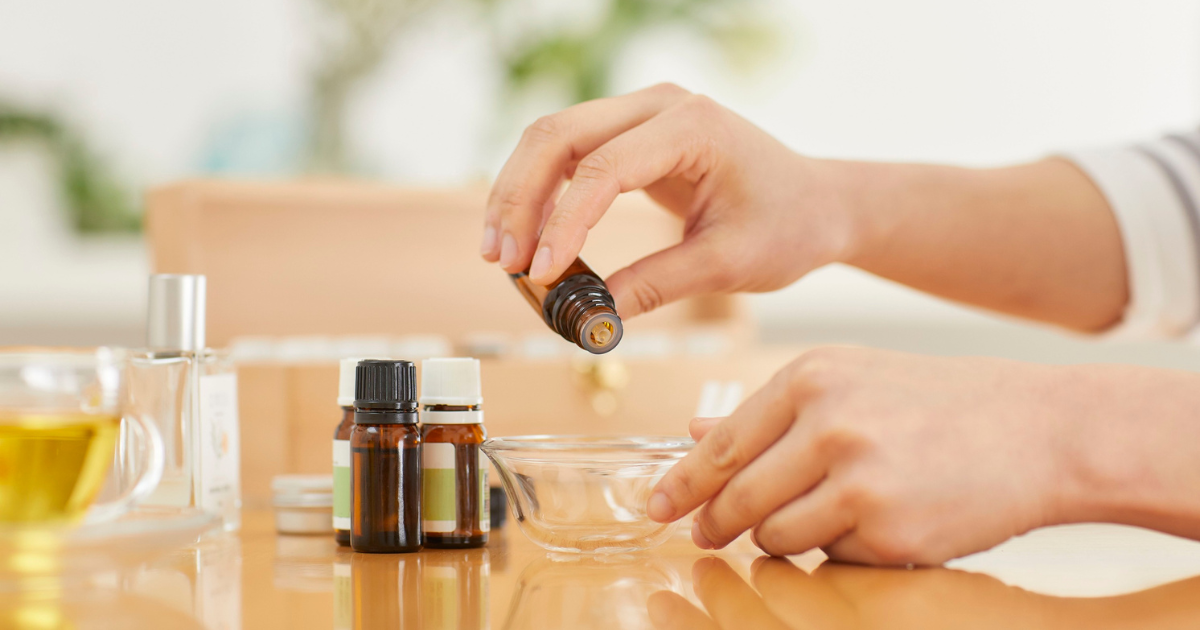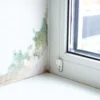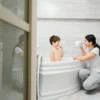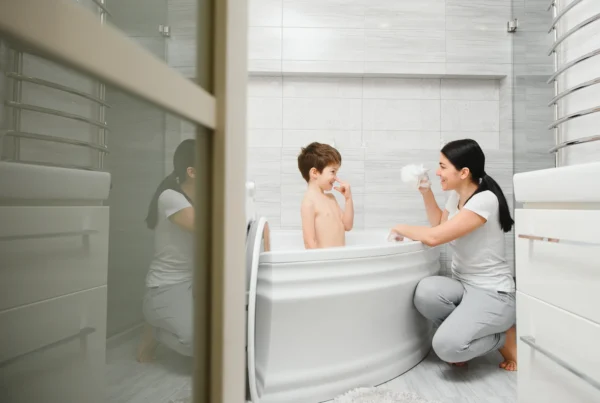Summary
Chronic sinus inflammation in children can be much more than a stuffy nose. When congestion lasts for weeks or months, it can affect how well a child sleeps, focuses, and feels throughout the day. Ongoing inflammation limits oxygen flow to the brain and increases overall immune stress, which can impact behavior, attention, and mood.
Supporting sinus health naturally starts with identifying what’s causing the inflammation. Common triggers include mold, dust mites, pet dander, and food sensitivities. Improving air quality in the home, reducing exposure to allergens, and keeping bedding clean can make a big difference.
Along with these environmental changes, certain natural tools can help relieve congestion and inflammation. Nasal sprays with saline or gentle antimicrobial blends, lymphatic drainage massage, nasal dilators, and steam inhalation can all help open the airways. Supplements such as proteolytic enzymes, quercetin, and vitamin C can also support sinus and immune health.
The goal is not only to relieve symptoms but also to improve how your child’s body processes inflammation overall. When the sinuses are clear, kids often sleep better, think more clearly, and feel calmer and more balanced.
FAQS
Q1. What causes chronic sinus inflammation in children?
Chronic sinus inflammation can result from ongoing exposure to irritants such as mold, dust mites, pet dander, or food sensitivities. These triggers cause swelling in the sinus tissues, making it harder for the body to drain mucus and breathe freely.
Q2. How does poor sinus health affect a child’s brain and behavior?
When sinuses are blocked, the brain receives less oxygen and inflammation can spread through the body. This can lead to brain fog, poor focus, irritability, restless sleep, and emotional ups and downs.
Q3. What environmental changes can help relieve sinus symptoms?
Improving air quality, using a HEPA filter, washing bedding frequently, reducing exposure to dust and mold, and managing humidity levels can all help keep the sinuses clear.
Q4. What natural therapies support sinus drainage and relief?
Helpful options include saline nasal sprays, lymphatic drainage massage, steam inhalation, nasal dilators, and gentle herbal or essential oil blends designed for children.
Q5. Are there supplements that can help reduce sinus inflammation?
Yes. Proteolytic enzymes, quercetin, vitamin C, and probiotics can support the immune system and reduce inflammation that contributes to sinus congestion. Always consult a practitioner before starting new supplements for children.
Q6. When should parents seek professional help for sinus problems?
If a child has persistent sinus pressure, mouth breathing, poor sleep, or recurring infections, it’s important to consult a practitioner who can assess underlying causes and guide safe, effective treatment options.
Introduction
When sinus inflammation becomes chronic, it doesn’t just cause congestion—it can reduce oxygen flow to the brain, contribute to systemic inflammation, and profoundly disrupt a child’s cognition, mood, and behavior.
Parents often report brain fog in children with sinus issues, or notice mood changes in kids with chronic sinusitis. Imagine your child struggling to focus in school, experiencing frequent mood swings, or having restless nights, all because their brain isn’t getting enough oxygen.
Identifying and addressing these underlying triggers is not just helpful; it’s absolutely crucial for their well-being and development.
Last week, we touched upon general lifestyle strategies to support sinus health, such as staying well-hydrated, utilizing essential oils, and incorporating anti-inflammatory foods into your child’s diet. These are excellent foundational steps.
However, for many of the families I work with, basic strategies aren’t enough to tackle persistent sinus issues.
That’s why today, we’re going to explore targeted tools and approaches for natural sinus relief in children. This isn’t about quick fixes, but about understanding the root causes and implementing comprehensive solutions for lasting relief.
Isolating Triggers for Natural Sinus Relief
One of the very first and most critical steps I recommend to families is to systematically identify potential inflammatory triggers, both those originating from within the body and those from the external environment. Think of it like being a detective in your own home, searching for clues that might be contributing to your child’s symptoms.
The Role of Food Sensitivities
Food sensitivities are a surprisingly common culprit behind chronic inflammation, including sinus issues. If formal food sensitivity testing isn’t an immediate option, don’t despair. Keeping a detailed food and symptom journal can be an incredibly powerful tool.
For several weeks, meticulously record everything your child eats and drinks, alongside any sinus symptoms they experience, noting the time and severity.
Look for patterns: Do symptoms worsen after consuming dairy? Is there a consistent flare-up after eating gluten? This journal can provide invaluable insights and guide targeted elimination diets.
Environmental Exposures
Environmental exposures—including dust mites, pollen, pet dander, and especially mold—often play a much bigger role in chronic sinus issues than many parents realize. If your child is consistently waking up congested every morning, it’s a significant red flag that their sleep environment might be contributing to their ongoing sinus inflammation. These microscopic invaders can continuously irritate the delicate sinus lining, hindering efforts for natural sinus relief.
Targeted Lab Testing
To truly get to the root causes of inflammation, especially when environmental factors are suspected, targeted lab tests can be immensely helpful. These tests provide objective data that can confirm suspicions and guide more precise interventions. Key tests I often recommend include:
✔ Urine mycotoxin testing for children (to assess mold exposure).
✔ Food sensitivity testing for kids with chronic illness.
✔ Environmental allergy testing for children.
If you’re looking for a professional to assess your home for environmental health concerns, including mold, I highly recommend exploring the Building Biology Institute’s Find an Expert directory.
These consultants, known as Building Biology Environmental Consultants (BBECs), are specifically trained to identify and mitigate a wide range of indoor environmental issues.
They can be invaluable in helping with finding a building biology consultant for mold concerns and other environmental toxins, paving the way for better natural sinus relief.
Optimizing the Sleep Environment for Natural Sinus Relief
Morning congestion is a strong indicator that your child’s sleep environment is likely playing a role in their ongoing sinus inflammation. Addressing these environmental factors can often lead to significant improvements in natural sinus relief. Consider making these changes to create a more sinus-friendly bedroom:
🛏️ Remove wall-to-wall carpeting (especially in bedrooms and play areas). Carpets are notorious for trapping dust mites, pet dander, and mold spores.
🧸 Remove stuffed animals from the bed. If your child can’t part with them, wash them regularly in hot water (at least 130°F or 54°C) or freeze them.
🌿 Reduce chemical exposure by using organic mattresses and sheets when possible.
💨 Add an air purifier (I like Austin Air or Air Doctor) with a HEPA filter to reduce airborne allergens.
🦢 Swap feather pillows for hypoallergenic alternatives.
🛏️ Wrap pillows and mattresses in dust mite-proof zippered covers.
Supplemental Support
In many cases, lifestyle and environmental changes are powerfully supported by targeted supplements. These can play an important role in reducing inflammation, supporting the body’s natural detoxification pathways, and helping to break up stubborn mucus. Some of the supplements I often incorporate into treatment plans include:
🌱 Proteolytic enzymes taken between meals – to help reduce pediatric sinus inflammation. Bromelain is a great choice.
💧 DesBio SINU-HC – a homeopathic sinus relief formula.
🌸 DesBio Allergy Rescue – great for managing spring allergies.
💧 DesBio Mucinease – supports the breakdown of upper respiratory mucus.
👃 Sinus Zapper – an essential oil blend that helps open sinus passages quickly, offering immediate natural sinus relief.
As always, please remember to check with your child’s healthcare practitioner or a qualified functional medicine doctor before starting any new supplements, especially with children.
Natural Tools You Can Use at Home for Natural Sinus Relief
Beyond supplements, there are several practical, natural tools you can incorporate into your child’s daily routine to support sinus health and provide relief.
Sinus Sprays for Natural Sinus Relief
Regular use of sinus sprays can be incredibly effective in keeping nasal passages clear, moisturized, and free from irritants. I often recommend rotating different types of sprays for best results.
💧 Saline spray: Your basic workhorse for keeping sinuses moisturized and flushing out irritants.
🩹 Nasalcrom: Contains cromolyn sodium, a mast cell stabilizer, which may help reduce allergic inflammation. You should be able to find this at your local pharmacy.
🧪 DIY Antimicrobial Sprays: For a more targeted approach, especially when infections or microbial imbalances are suspected.
Hydrogen Peroxide Spray:
Mix 4 parts filtered water with 1 part food-grade 3% hydrogen peroxide.
Homemade Nasal Spray with Essential Oils:
You’ll need:
🧴 1 glass vertical spray bottle
💧 Distilled or previously boiled water
🧂 1 saline packet (follow package directions)
🌿 High-quality, pure essential oils (choose three from the list below)
Directions:
1. Mix the saline packet into the recommended amount of water.
2. Fill a glass vertical spray bottle about three-quarters full with the saline solution.
3. Add 1–3 drops of each chosen oil.
4. Shake well before each use and spray twice daily.
Recommended Essential Oils (choose three):
🌿 Cinnamon
🌿 Clove
🌿 Cedar
🌿 Rosemary
🌿 Tea tree
🌿 Frankincense
🌿 Holy basil
🌿 Cumin
🌿 Eucalyptus
🌿 Pine
If sinus sprays are too difficult for your child, consider diffusing these essential oils in their bedroom or common areas. This can still provide significant aromatic and therapeutic benefits for opening sinus passages and promoting natural sinus relief.
Lymphatic Sinus Drainage Massage
This gentle massage technique can be incredibly soothing and effective for relieving pressure and encouraging natural sinus drainage. It works by stimulating the lymphatic system, which helps remove waste products and excess fluid from the tissues. Here’s a great video to guide you. Performing this massage regularly can significantly reduce discomfort and aid in natural sinus relief.
Nasal Dilators
For kids with anatomically narrow nasal passages, nasal dilator tape or soft inserts may significantly improve nighttime airflow and reduce congestion. These devices gently open the nostrils, making it easier to breathe through the nose while sleeping. Improved nasal breathing during sleep can lead to better oxygenation and less morning congestion, contributing to overall natural sinus relief.
Final Thoughts: The Profound Impact of Natural Sinus Relief
When a child’s brain is under-oxygenated because of chronic sinus issues, it’s incredibly challenging for them to function at their best—no matter how hard they’re trying. This chronic lack of optimal oxygen can impact their learning, their behavior, their emotional regulation, and their overall vitality. It’s a common reason why children might struggle with focus or experience unexplained behavioral shifts. That’s why supporting sinus health in a targeted, personalized way, often through a functional medicine approach, can make such a profound difference in their lives.
The tools and strategies I’ve recommended in this blog post are the very ones I use every day in my practice with families who are navigating chronic sinus challenges. My hope is that they provide you with some much-needed clarity, actionable steps, and effective options as you embark on your journey to support your child’s healing and help them breathe easier and experience true natural sinus relief.







